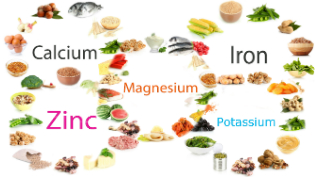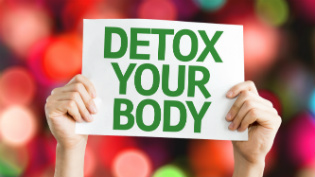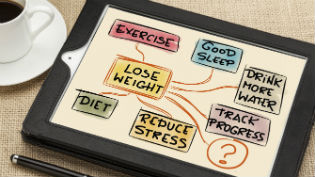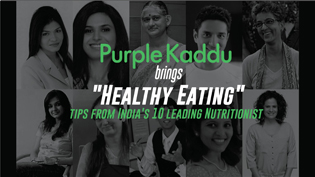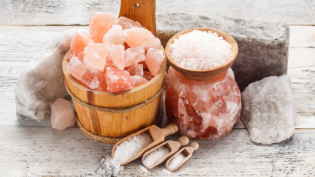
A handy guide on Vitamins- Type, Functions & Sources-

From school we have been taught about vitamins and their importance for health, but do you still remember those mugged up lines? Guess 'No'. Hence, let us put you through the ABC’s of these vital nutrients and their food sources. There are a total of 13 vitamins - 4 are fat soluble (present in the fat of your body) and 9 are water soluble (present in the water of your body).
Did you know? -
⇒Vitamins and minerals closely interact with each other and influence each others functions. They work hand in hand, thus any imbalance between them is undesirable.
⇒Proteins help vitamins travel from one place to another. They act as transporters/vehicles. Thus, if you are deficient in protein and pop vitamin pills, your body does not benefit from it.
Fat soluble vitamins:
They are stored in the liver and fat tissues and are released as and when required. These vitamins require some amount of fat to get absorbed (so, deleting fat from from your diet is not a good option).
Vitamin A
Function in Body:
- Maintaining good skin, hair, eyesight
- Proper development of body cells
- Boost immunity
Foods that are Rich Sources:
- Yellow and orange coloured fruits and vegetables such as papaya, mango, carrots, pumpkin
- Green leafy vegetables such as drumstick leaves, spinach, fenugreek, colocasia leaves
- Dairy products
- Animal Liver,
- Egg
Vitamin A is fat soluble and hence will be stored in the liver. For it to move out and perform its role, Zinc is required. Zinc also helps in the making of a protein (Retinol Binding Protein), which helps transport Vitamin A through the blood. Thus, indirectly Zinc works to let Vitamin A work. It's a mutual relationship. Meal combinations which lets you benefit from both are Palak Dal or Chhole Paneer.
Impact of Deficiency:
- Night blindness
- Poor Immunity
- Slow bone growth
Vitamin D
Function in Body:
- Strong Bones and Teeth
Foods that are Rich Sources:
- Fish
- Eggs
Morning Sun light is god source of this vitmain. All you have to do is bask in the morning sun for atleast 15 minutes and you are good to go.
Calcium from foods gets absorbed by binding to calbindin. Now, this function of calbindin depends on the presence of Vitamin D. This implies that even if you eat a diet rich in calcium, your body does not get the calcium, unless your Vitamin D levels are adeqaute. Fish lets you benefit from both these micronutrients at one go.
Impact of Deficiency:
- Rickets or bow shaped legs in children
- Softening of bones (osteomalacia)
- Porosity in bones and easy fractures (Osteoporosis)
- Obesity - Recent Researches suggest that Vitamin D deficiency may be a causative factor for obesity
Vitamin E
Function in Body:
- Protects blood cells, body tissue and essential fatty acids.
- Acts as an antioxidant thus providing immunity
Recent Research indicates that Vitamin E helps maintain the nervous system.
Foods that are Rich Sources:
- Peanuts
- Sunflower seeds
- Pumpkin seeds
- Flaxseeds (all vegetable oil seeds)
- Vegetable oil
Vitamin E acts as an anti-oxidant. While performing this function, Vitamin E becomes unstable. It's conversion back to it's original form requires Vitamin C. These micronutrients thus interact synergestically.
Impact of Deficiency:
- Not Very Common
Vitamin K
Function in Body:
- Proper clotting of blood in wounds
- Healthy bones
Foods that are Rich Sources:
- Spinach
- Amaranth leaves
- Broccoli
There isn't much data on interaction of nutrients with Vitamin K. However, pharmacological / high doses of Vitamin A or Vitamin E can interfere with Vitamin K absorption and activity.
Impact of Deficiency:
- Can lead to haemorrhage (uncontrolled bleeding)
Water soluble vitamins:
Water soluble vitamins can easily get low in body as they are lost through urine; thus consistent daily intake of these vitamins is required. Let us tell you about their importance and foods rich in these vitamins.
Vitamin B1 (Thiamine)
Function in Body:
- Helps in releasing energy from food (carbohydrate) in the body
- Important for growth and maintaining good tone of muscles
Foods that are Rich Sources:
- Whole grains
- Pulses
- Groundnut
- Capsicum
In our body, for B1 to perform its role, it must get converted to Thiamine Pyrophosphate (TPP). This conversion requires Magnesium. Thus, sufficient amounts of Magnesium ensures adequate B1 levels.You generally need not worry about this nutrient combination, because whole grains contain both.
Impact of Deficiency:
Deficiency is common among chronic alcoholics and people who consume polished rice as a major diet, causing a condition called “Beri beri” whose symptoms are:
- Muscle weakness,
- Mental confusion,
- Poor growth
- Water retention in body
Recent Research: Thiamine deficiency has been found to be present in Type 2 diabetics.
Vitamin B2 (Riboflavin)
Function in Body:
- Helps release energy from food
- Improves vision
- Makes your skin healthy
Foods that are Rich Sources:
- Milk
- Egg
- Soyabean
- Green leafy vegetables
Riboflavin and Iron are interlinked. If B2 levels are low, it can impair iron uptake. Iron will thus not be available for formation of haemoglobin. Thus, deficiency of one alters functioning of the other. Soyabean and green leafy vegetables nourish your body with both these nutrients.
Impact of Deficiency:
- Leads to a condition called Glossitis (magenta and swollen) tongue
- Cracks around the mouth
- Cataract
Vitamin B3 (Niacin)
Function in Body:
- Required for proper digestion
- Normal appetite
- Healthy skin and nerves
Foods that are Rich Sources:
- Peanuts
- Animal Organ meats
- Nuts
- Legume
- Whole grains
The body receives B3 naturally through foods and also through an amino acid, tryptophan, found in protein.The conversion of tryptophan to Niacin (B3) requires Vitamin B1 and B6. The importance of a well balanced diet is thus crucial. Whole grains, legumes, nuts are fair sources containing these nutrients.
Impact of Deficiency:
Deficiency of B3 causes a life threatening condition called Pellagra whose symptoms are
- Cramps
- Mental confusion
- Nausea
- Skin problems
Vitamin B5 (Pantothenic acid)
Function in Body:
- Required for energy production in body
- Formation of hormones
- Release of energy from food
Foods that are Rich Sources:
- Animal Liver
- Egg yolk
- Whole grains (barley, wheat)
- Lean meat
- Legume (bengal gram, red gram, soya)
High doses of Vitamin B5 interfere with absoprtion of B7. Thus, pharmacological supplementation must be under medical supervision.
Impact of Deficiency:
- Not Very Common
Vitamin B6 (Pyridoxine)
Function in Body:
- Required for production of red blood cells and other chemicals in body like haemoglobin.
- Helps reduce homocysteine levels
Foods that are Rich Sources:
- Meat
- Animal Liver
- Vegetables
- Whole Grains & Cereals
Vitamin B6, B9 and B12 all three work together for breakdown of homocysteine. Increased levels of homocysteine has been linked to cardiac diseases. Thus, their function is of utmost importance. Meal combinations such as animal foods along with green leafy vegetable ensures you get all the three.
Impact of Deficiency:
- Skin disorders
- Anaemia
- Convulsions
Vitamin B7 (Biotin)
Function in Body:
- Energy production from fats, protein and carbohydrate
- Good nervous system, hair and skin
Foods that are Rich Sources:
- Chicken liver,
- Egg yolk,
- Soyabean
Impact of Deficiency:
Deficiency is rare and symptoms are:
- Hair loss
- Red rash around the eyes, nose, genital area
- Hallucinations
- Depression
Vitamin B9 (Folic acid)
Function in Body:
- Required for genetic material development
- Red blood cell formation
- Helps reduce risk of coronary heart disease.
- Important before and during pregnancy to prevent birth abnormalities of brain and spinal cord like spina bifida and anencephaly (absence of portion of brain)
Foods that are Rich Sources:
- Dark green leafy vegetable
- Legume
Impact of Deficiency:
- Causes a type of anaemia called megaloblastic anaemia
Vitamin B12 (Cobalamine)
Function in Body:
- Needed for genetic material building
- Making of red blood cells
- For a good nervous system
Foods that are Rich Sources:
- All animal foods ( milk, meat, fish, egg)
Impact of Deficiency:
Usually occurs in strict vegans (who eat no animal products) and elderly. Symptoms are:
- Pernicious anaemia
- Fatigue
- Poor maintenance and functioning of nervous system causing sensation of numbness and tingling in the body.
Vitamin C
Function in Body:
- Making collagen (a tissue that holds bones, muscles and other tissues together),
- Wound healing, Improving immunity (antioxidant), strengthening blood vessels
- Proper formation of bones and teeth.
- It also helps in absorption of iron from animal foods
Foods that are Rich Sources:
- Fruits such as guava, amla, oranges, berries
Impact of Deficiency:
Usually occurs in strict vegans (who eat no animal products) and elderly. Symptoms are:
- Tooth decay and loss
- Poor wound healing
- Bleeding and swollen gums (scurvy)
- Poor immunity
Cooking tips to retain Vitamins in Food:
Exposure to air, heat and water can destroy vitamins. Hence, transfer of these from food sources into the body becomes difficult. Some tips to keep in mind while dealing with vitamin rich foods are listed below-
- Since Vitamin A is fat soluble, deep frying of vitamin A rich foods must be avoided.
- Discarding milk fat makes you loose out on Vitamin A too. Thus instead of opting for skim milk, one must cut down on fatty fried foods.
- Use of soda while cooking promotes loss of Thiamine (Vitmain B1). Tea, coffee, betel nut contain anti-thiamine substances which bring about destruction of Thiamine in the body. High temperature cooking(baking,pasteurisation,vigorous boiling) too causes lose of Thiamine.
- Milling of cereals causes loss of outer bran layer thereby losses of Vitamin B2.
- Vitamin B3 is relatively stable to heat, air, light. Slight loses while cooking in water do occur.
- Folate (Vitamin B9) losses occur while boiling vegetables in excess water.
- B12 is stable at room temperature and not easily destroyed by cooking. However, microwave heating is shown to hamper B12 content of foods.
- Vitamin C is the most easily destroyed. High temperature cooking, cooking in and then discarding excess water, mashing or cutting vegetables into small pieces and dehydration of fruits and vegetables causes considerable loss.
Now that you know your ABCs and 1, 2, 3s of Vitamins, grab onto foods to get your fill of them and enjoy a “V-ealthy” life!




